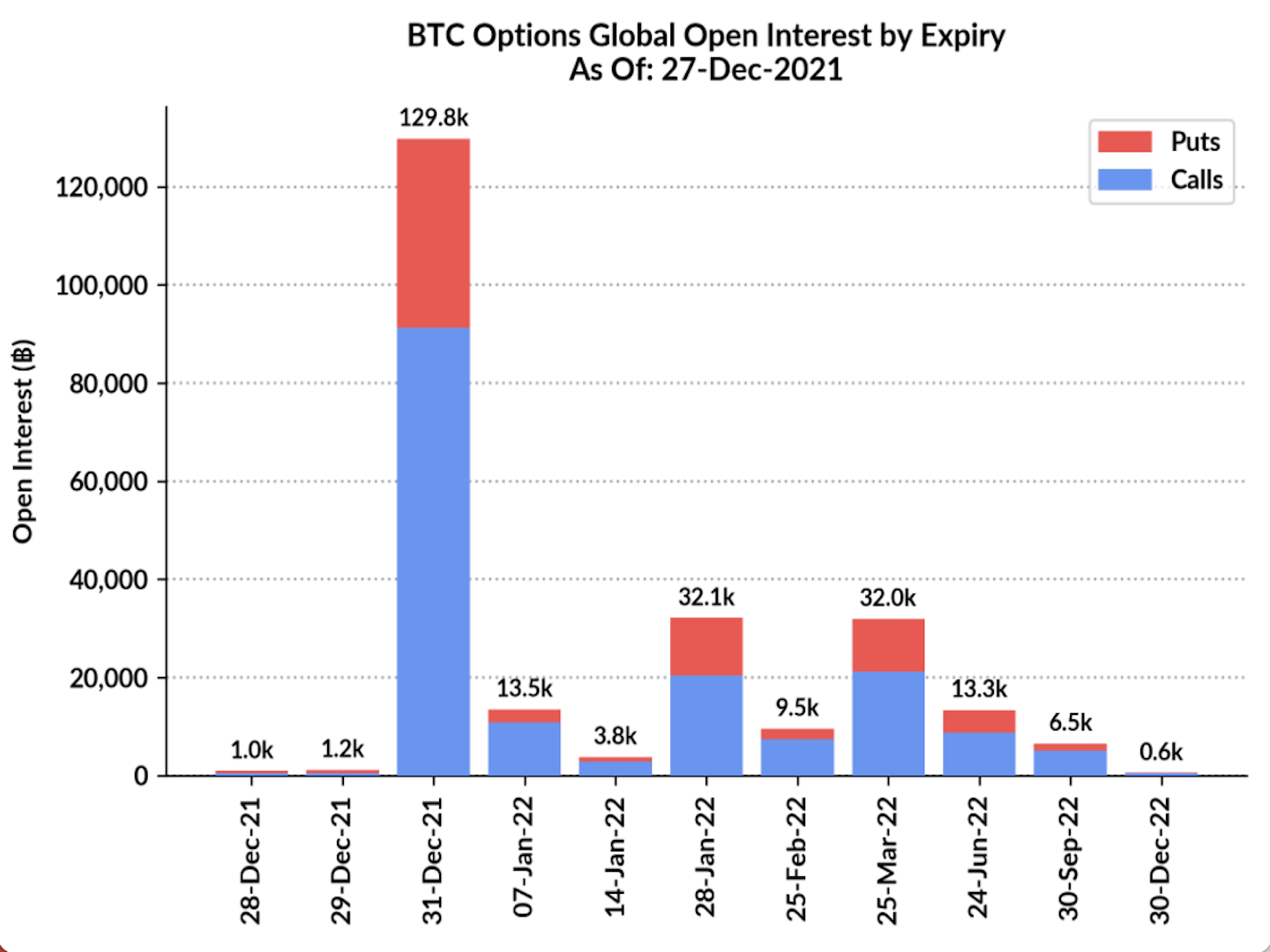A total of 129,800 option contracts worth more than $6 billion are set to expire on Friday; ether’s price plummets.
Good morning. Here’s what’s happening:
Market moves: Bitcoin slumps below $48,000, as December’s options expiration nears
Technician’s take (Editor’s note): Technician’s Take is taking a hiatus for the holidays. In its place, First Mover Asia is publishing CoinDesk reporter Sanadali Handagama’s interview with European Parliament member Eva Kaili. The discussion covered MiCA, the current regulatory frenzy over stablecoins, Web 3 and of course, Facebook’s Diem.
Prices
Bitcoin (BTC): $47,701 -6.2%
Ether (ETH): $3,813 -5.7%
Markets
S&P 500: $4,786 -0.1%
DJIA: 36,398 +0.2%
Nasdaq: $15,781 -0.5%
Gold: $1,807 -0.2%
Market moves
Bitcoin, the oldest cryptocurrency, dropped by more than 6% to under $48,000 during the U.S. trading day on Tuesday, despite continued muted spot market activities.
While the spot trading volume of bitcoin remained mostly unchanged from a day ago, its price turbulence came as the market headed into monthly options expiration.
A total of 129,800 option contracts worth more than $6 billion are set to expire on Friday, according to data provided by Skew. As CoinDesk reported previously, data shows that bitcoin tends to move toward the “max pain” point in the lead-up to an expiration and sees a solid directional move in days after settlement.
Credit: Skew
This price move trend usually comes from spot market manipulations by option sellers (mostly institutional traders) to push the spot price closer to the strike price at which the highest number of open options contracts expire worthlessly. That creates maximum losses – so-called max pain – for option buyers. The max pain point for Friday’s option expiration is $48,000, according to Cayman Islands-based crypto financial services firm Blofin.
Q&A – Eva Kaili
The View From Brussels: How the EU Plans to Regulate Crypto: European Parliament member Eva Kaili says Facebook’s libra announcement in 2019 catalyzed lawmakers into action on digital assets. (By CoinDesk reporter Sandali Handagama)
The European Union (EU) wants to regulate the digital asset industry; there are a number of bloc-wide initiatives already underway. The most comprehensive is a 168-page “Markets in Crypto-Assets” (MiCA) that would create an EU-level licensing framework for crypto issuers and service providers.
But crypto regulations are only one part of a larger Web 3.0 governance strategy for the political and economic union of 27 nations.
This feature is part of CoinDesk’s “Policy Week,” a forum for discussing how regulators are reckoning with crypto (and vice versa).
According to Eva Kaili, a member of the European Parliament, the new proposals for digital assets, data and artificial intelligence (AI) were all inspired by the General Data Protection Regulation (GDPR) of 2016, which sought to strengthen consumers’ control over how their data is used by companies allowed to operate in the EU.
For digital assets in particular, the catalyst was Facebook’s 2019 plans to build its own stablecoin, libra (now diem), a digital token backed by a basket of currencies and assets, Kaili said. She added that regulatory clarity for digital finance is key to fostering innovation and protecting citizens freedom and sovereignty from being exploited by Big Tech.
Kaili is a Greek politician, a member of the Progressive Alliance of Socialists and Democrats in the European Parliament; she was elected in 2014. Kaili has advocated for innovation-friendly regulations for distributed ledger technology (DLT) applications and decentralized finance (DeFi).
CoinDesk got a chance to speak to Kaili about her views on MiCA, the current regulatory frenzy over stablecoins, Web 3.0 and, of course, Facebook’s Diem.
The following has been lightly edited for brevity and clarity.
The first framework is “Markets in Crypto-Assets, or MiCA. It’s part of the EU’s digital finance strategy, and it tries to deal in a holistic manner with the crypto ecosystem to establish clear and new licensing requirements that are passport-able. And this means we were trying to pave the way [by] initiating a robust regulatory response, as we did with GDPR.
MiCA will allow firms to operate across the EU, and also set stronger consumer protection standards. It also sets out rules for digital asset issuance and public offerings, and has some specific requirements relating to stablecoins. It lays out additional requirements for the big, systemically important stablecoins, too. MiCA is going through its first readings [in the parliament], so it has some way to go. There have been no consultations between the EU parliament and council yet.
Then you have the pilot regime for market infrastructures based on DLT. I am a rapporteur [the person who gives reports] on that one. I would say it’s not only an ambitious project but also a much anticipated sandbox project. It’s quite unique for the EU because it’s aiming to test new business models deploying DLT in the EU financial infrastructure, and the provisions will translate into a huge testing environment that will operate in a uniform manner across the EU, just like what MiCA is trying to do for crypto assets. It would offer concrete testing outcomes, and then this would feed the future policymaking and regulatory adaptation. So when you are exiting the sandbox, you are participating in creating the regulatory framework to follow. It has gone through the EU Council and parliament first readings, and it seems to go through these negotiations quite smoothly.
CoinDesk: A lot of EU regulators are showing concern over stablecoins, and MiCA is considerably focused on regulating stablecoins in particular. Why is that?
Kaili: Back in 2019, the discussions around Facebook’s stablecoin, libra, now called diem, led us to accelerate legislative initiatives and to explore what could happen if we have global currencies coming from not just central banks but also from private players. Certain stablecoins could work on a global level, and have a global reach. They are what the EU calls significant e-money tokens. They are addressed by MiCA because they could indeed raise concerns regarding the EU monetary policy, stability and sovereignty. But this is not just an EU concern.
Since several countries are now exploring central bank digital currencies including China and Russia, I would say that global stablecoins can have unprecedented effects on all economies because of the connectedness of the financial system. And also consider that for the first time in more than a century, the U.S. dollar supremacy is being challenged. The rise of cryptocurrencies and stablecoins may be forcing us to rethink what a currency is, who regulates it, and what it means if it’s not controlled by the national government.
Then, we have this political dimension that we have to take under consideration. Even if we don’t want to admit it, we have to have central bank digital currencies because it’s a matter of geopolitical dominance. It can also become a matter of monetary sovereignty, especially when you don’t have like-minded countries deploying similar platforms and marketplaces.
Kaili: The upcoming regulatory initiatives are designed to provide legal certainty and to test these new technologies in collaboration with traditional players and stakeholders. It will hopefully be completed by the end of 2022.
All writers’ opinions are their own and do not constitute financial advice in any way whatsoever. Nothing published by CoinDesk constitutes an investment recommendation, nor should any data or Content published by CoinDesk be relied upon for any investment activities. CoinDesk strongly recommends that you perform your own independent research and/or speak with a qualified investment professional before making any financial decisions.
Recommended Content
Editors’ Picks

Bitcoin holds $84,000 despite Fed’s hawkish remarks and spot ETFs outflows
Bitcoin is stabilizing around $84,000 at the time of writing on Thursday after facing multiple rejections around the 200-day EMA at $85,000 since Saturday. Despite risk-off sentiment due to the hawkish remarks by the US Fed on Wednesday, BTC remains relatively stable.

Crypto market cap fell more than 18% in Q1, wiping out $633.5 billion after Trump’s inauguration top
CoinGecko’s Q1 Crypto Industry Report highlights that the total crypto market capitalization fell by 18.6% in the first quarter, wiping out $633.5 billion after topping on January 18, just a couple of days ahead of US President Donald Trump’s inauguration.

Top meme coin gainers FARTCOIN, AIDOGE, and MEW as Trump coins litmus test US SEC ethics
Cryptocurrencies have been moving in lockstep since Monday, largely reflecting sentiment across global markets as United States (US) President Donald Trump's tariffs and trade wars take on new shapes and forms each passing day.

XRP buoyant above $2 as court grants Ripple breathing space in SEC lawsuit
A US appellate court temporarily paused the SEC-Ripple case for 60 days, holding the appeal in abeyance. The SEC is expected to file a status report by June 15, signaling a potential end to the four-year legal battle.

Bitcoin Weekly Forecast: Market uncertainty lingers, Trump’s 90-day tariff pause sparks modest recovery
Bitcoin (BTC) price extends recovery to around $82,500 on Friday after dumping to a new year-to-date low of $74,508 to start the week. Market uncertainty remains high, leading to a massive shakeout, with total liquidations hitting $2.18 billion across crypto markets.

The Best brokers to trade EUR/USD
SPONSORED Discover the top brokers for trading EUR/USD in 2025. Our list features brokers with competitive spreads, fast execution, and powerful platforms. Whether you're a beginner or an expert, find the right partner to navigate the dynamic Forex market.
